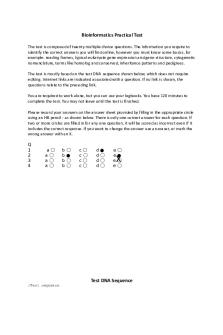BIOL230 Bioinformatics karan Virk PDF

| Title | BIOL230 Bioinformatics karan Virk |
|---|---|
| Author | karan virk |
| Course | Principles of Genetics |
| Institution | University of Victoria |
| Pages | 3 |
| File Size | 139.5 KB |
| File Type | |
| Total Downloads | 76 |
| Total Views | 165 |
Summary
UVIC bioinformatics assignment ...
Description
Name:
BIOINFORMATICS IN-CLASS WORKSHEET, BIOLOGY 230 Total:
/14
1. (2 points) pufC forward primer: 5' – GCTGGCCGAACAGATCCCG pufC reverse primer: 5' – GGATAGTCCTTGGCCATCTGC Write out the reverse-complement of the primer sequences: Forward primer reverse-complement: 5’ – CGGGATCTGTTCGGCCAGC Reverse primer reverse-complement: 5’ – GCAGATGGCCAAGGACTATCC 2. (3 points) Indicate the length of the clones after trimming vector and pufC sequences. Note: BioEdit will sometimes remove an extra base or two when you remove primer and vector sequences, and so you may find the resulting sequence lengths to be a little different from your colleagues. This is OK! Clone 1: 806 Clone 2: 806 Clone 3: 832 3. (9 points) Nucleotide BLAST search results: Clone 1: Description of 1st hit Accession no. Rubrivivax gelatinosus puf operon D16822.1
Description of 2nd hit Rubrivivax gelatinosus IL144 DNA
Accession no. AP012320. 1
Query cover 100%
Query cover 100%
E value 0.0
E value
Identity percent 100%
Identities
Identity percent 99%
Identities
806/806
804/806
Is clone 1 a pufC sequence? Is it the same as a pufC sequence from a known bacterium, or similar? Incorporate the Query cover, E value, Identity percent and number of Identities in an explanation of the BLAST results for Clone 1.
Yes, Clone 1 is a pufC sequence. It is the same sequence from β subclass of purple bacteria ,Rubrivivax gelatinosus puf operon.Query cover is how much the sequence matches. Showed the sequence matched exactly Clone 1. Identity percent, how much the sequence aligns. Showed that the sequence aligns exactly with clone 1. E value, the lower the E value the better. Shows how much it matches with other sequences. The blast results showed an optimal E value. E-values were 0 indicating no chance of The alignment with another sequence. For second the number of identities show that only 904 base pairs matched out 806.
Name:
Clone 2: Description of 1st hit Rubrivivax gelatinosus S1 Cyc8L
Description of 2nd hit Rubrivivax gelatinosus IL144 DNA
Accession Query no. cover AH01271 100% 0.2 Accession Query no. cover Ap012320. 99%
E value 0.0
E value 0.0
Identity percent 100%
Identity percent 97%
Identities 806/806
Identities 778/803
1
Is clone 2 a pufC sequence? Is it the same as a pufC sequence from a known bacterium, or similar? Incorporate the Query cover, E value, Identity percent and number of Identities in an explanation of the BLAST results for Clone 2. Yes, clone 2 is also a pufC sequence. The bacterium β subclass of purple bacteria, Rubrivivax gelatinosus S1 Cyc8L. Identity percent was not perfect for second hit indicating the sequence did not align perfectly. E-values were 0 indicating no chance of alignment with another sequence. However Identify percent was not 100% for second hit indicating the alignment was not perfect. Number of identities were 806/806 exactly matched number of nucleotide bases. However, for the second hit was 778/803 indicating nucleotides were not perfectly aligned. The query cover was 100% for the first hit showing perfect alignment
Clone 3: Description of 1st hit
Accession no.
Roseateles depolymerans strain KCTC 42856
CP013729. 1
Description of 2nd hit
Accession no.
Query cover 99%
Query cover
E value 0.0
E value
Identity percent 100%
Identity percent
Identities 830/830
Identities
Name: Roseateles depolymerans DNA for puf operon,
AB028938 .1
99%
0.0
100%
830/830
Is clone 3 a pufC sequence? Is it the same as a pufC sequence from a known bacterium, or similar? Incorporate the Query cover, E value, Identity percent and number of Identities in an explanation of the BLAST results for Clone 3.
Yes, clone 3 is also a pufC sequence. The Roseateles depolymerans matched photosynthetic bacteria. Identity percent was perfect for second hit and first hit indicating the sequence did not align perfectly. Evalues were 0 indicating no chance of alignment with another sequence. Number of identities were 830/830 exactly matched number of nucleotide bases. The query cover was 99% showing sequence aligned almost correctly for second hit and first hit....
Similar Free PDFs

Bioinformatics project
- 21 Pages

Bioinformatics 2
- 14 Pages

Karan Goswami Resume
- 3 Pages

Bioinformatics lab
- 3 Pages

Bioinformatics Exercise
- 15 Pages

Bioinformatics - Notes
- 2 Pages

Bioinformatics Practical Test
- 6 Pages

bioinformatics essay final version
- 16 Pages

Bioinformatics Quiz Questions
- 1 Pages

3 Role of Bioinformatics in Crop
- 13 Pages
Popular Institutions
- Tinajero National High School - Annex
- Politeknik Caltex Riau
- Yokohama City University
- SGT University
- University of Al-Qadisiyah
- Divine Word College of Vigan
- Techniek College Rotterdam
- Universidade de Santiago
- Universiti Teknologi MARA Cawangan Johor Kampus Pasir Gudang
- Poltekkes Kemenkes Yogyakarta
- Baguio City National High School
- Colegio san marcos
- preparatoria uno
- Centro de Bachillerato Tecnológico Industrial y de Servicios No. 107
- Dalian Maritime University
- Quang Trung Secondary School
- Colegio Tecnológico en Informática
- Corporación Regional de Educación Superior
- Grupo CEDVA
- Dar Al Uloom University
- Centro de Estudios Preuniversitarios de la Universidad Nacional de Ingeniería
- 上智大学
- Aakash International School, Nuna Majara
- San Felipe Neri Catholic School
- Kang Chiao International School - New Taipei City
- Misamis Occidental National High School
- Institución Educativa Escuela Normal Juan Ladrilleros
- Kolehiyo ng Pantukan
- Batanes State College
- Instituto Continental
- Sekolah Menengah Kejuruan Kesehatan Kaltara (Tarakan)
- Colegio de La Inmaculada Concepcion - Cebu




